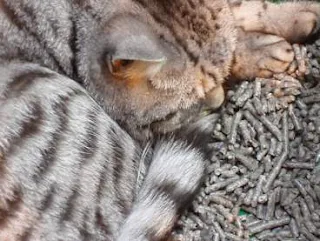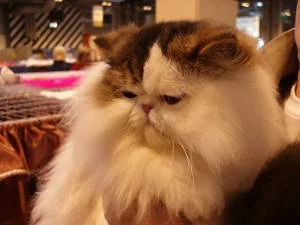The photographs illustrating this article are by Helmi Flick and copyright Helmi Flick. Please respect copyright.
 |
| American Bobtail cat - tabby pattern |
There are some myths surrounding both the American Bobtail and Pixie-Bob. Both are now distinct cat breeds shown at cat shows. Both have short tails and both have the look of the wild to a certain extent, although not as much as the exotic breeds such as the Savannah. That said the Savannah's parent is the
Serval an African wild cat. While the
Bobcat, the possible ancestor of the American Bobtail, is an American wild cat (different look).
Some think that both the American Bobtail and
Pixie-Bob are the result of an American Bobcat (a wild medium sized cat with a short tail) mating naturally (without human intervention) with a domestic cat. As nice as this idea is there is no genetic evidence to support it. Although wildcats do mate with domestic cats sometimes. The American Bobtail originates from a feral cat that had a short tail due to a genetic mutation. The short tail caught the eye of those who found the cat. The cat was mated with a long haired cat and the breed developed from there.
I took a long time for the breed to gain full recognition by the cat registries. The CFA granted Championship status May 1st 2006. TICA granted Championship status in 2002.
The mutation is dominant meaning at least half of the litter will have the short tail if bred with a non-short tailed cat. There is a Japanese short tailed cat as well.
 |
| American Bobtail - lynx pointed |
The breed began in the 1960s, when the idea of keeping domestic cats that had a wild appearance was relatively new. Now there are a number of cat breeds that satisfy the public's desire to live with and be near a wild cat with the temperament of a domestic cat.
This cat is reportedly well balanced, friendly, good with other animals and can be leash trained. The breed is intelligent. I am not sure about the idea of
some breeds being more intelligent than others. Is this possible? Maybe. It is said that the Bobtail's origins as a feral cat has imbued the cat with intelligence.
People who live with the exotic domestic "wild cats" such as the
Chausie say that they are more intelligent, dog like and that they learn from your actions.
This cat is healthy (probably due to the mixed genes). Although the genetic mutation that reduces the length of the spine and so produce the short tail can it seems result in ill health if the shortening goes too far.
The American Bobtail can have either medium-long hair or short hair and a wide range of coat color and patterns. This is a medium to large cat with a powerful build. The tail should be 1.5 to 6 inches in length and not kinked (source: Legacy of the Cat).
American Bobtail Breed Information
See a lot more on this cat breed. This linked page contains more pictures - the best - and a lot of breed information. It is pretty comprehensive.
American bobtail cat rescue
American Bobtails are purebred cats of course. I am minded to think of
an article recently written by a regular contributor, Maggie, which highlights the need for us all to consider how we go about adopting a cat. If are mind is set on an American Bob then we should at first try and rescue one! This is a more difficult route than simply going to a breeder but more rewarding.
This page on
Purebred Cat Rescue might help. Yahoo Groups can help but the ones I see are for breeders only, sadly.
This page may help.
American Bobtail Breeders
The American Bobtail Breeders Club has
a nice list. Why not ask if they know of a cat that needs re-homing?
The CFA is a good and reliable source of breeders but a page that is hard to find! This is the page:
CFA Breeder Referral Search - select "one or more of the following breeds" and then select the breed. There are just two listed. Not brilliant.
TICA the next largest cat association also list breeders. They list four.
Click here to see the list.
The above are probably the best sources and certainly good starting points for breeders in the USA. Be careful when buying/adopting. Highly recommended: visit the breeder/seller. Use your instincts to judge the facility etc. I had difficulty finding a UK breeder. I found bobtails for sale but they looked dodgy to be frank. Exercise caution please. We don't want to encourage poor breeders and the breeding of unhealthy kittens who live a miserable life.
American Bobtail Temperament
Gloria Stephens of legacy of the cat - a fine book - says that this cat is calm and intelligent and as a consequence "easy to live with". I have heard this before.
Helmi Flick who has photographed thousands of stunning purebred show cats says that this is a nice cat to work with.
American Bobtail Breed Standard
Gloria makes the point that as at the date of publication of her book 2001 the breed standard was evolving. This though is not unusual. Breed standards can vary between the cat associations. Click here for
TICA breed standard (PDF file) and click here for the
CFA breed standard (updated 2008 - PDF file).
American Kurilian Bobtail
My research indicates that some people search for the above. This must be a reference to the Russian cat breed that is called Kurilian Bobtail.
Click on this link to read more about this relatively rare cat. Some breeders in America are listed.
From American Bobtail to POC American Bobtail
 Photograph reproduced under creative commons, copyright YanivG (Flickr). This is not Binnie Do, my cat, just a well made but very sad photo of an old cat. The upload of this photo has made this cat look in worse condition than the original photo on Flickr. Remember though there a lot of feral cats like this.
Photograph reproduced under creative commons, copyright YanivG (Flickr). This is not Binnie Do, my cat, just a well made but very sad photo of an old cat. The upload of this photo has made this cat look in worse condition than the original photo on Flickr. Remember though there a lot of feral cats like this.



































